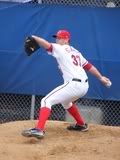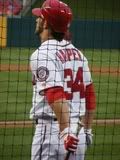A Rising Tide in Washington
June 13, 2012 by Ted Leavengood · 2 Comments
The Potomac River is near flood stage as it boils through the rapids at Great Falls, a crescendo of roaring noise. Further downstream from that much photographed natural beauty, at Nationals Park, a wave of human noise has not even begun to crest as fans of the Washington Nationals cheer a team that has risen in the NL East to first place and a level of recognition once hard to imagine.
At the beginning of the week, the Nationals were ranked second among the thirty major league teams in FanGraphs’ highly respected power rankings. It may be a watershed moment, marking the first public recognition of Washington”s prodigious talent. Or it may be a blip on the screen, a flash in the early season quickly forgotten. Either way, it is worth looking behind the numbers to see what is driving them and whether they accurately reflect a team on the rise, or one that is at its zenith, likely to plateau and fall.
The team’s prominence redounds to the pitching staff, still the best in either league by a comfortable margin.  Pitching is the most unstable of commodities, however. Injuries abound and hitters figure out young pitchers with blazing arms and quickly restore their modesty. So there is an uncertainty principle in play when calculating the long term stability of the foundations created by the Nationals with so much of their early dominance coming from their young arms.
Pitching is the most unstable of commodities, however. Injuries abound and hitters figure out young pitchers with blazing arms and quickly restore their modesty. So there is an uncertainty principle in play when calculating the long term stability of the foundations created by the Nationals with so much of their early dominance coming from their young arms.
The Nationals pitching staff is the youngest in the National League, under 27 years. The Braves and Reds are close and when you factor out Livan Hernandez, the Braves may be even younger. For their age, however, the Nationals starters are relatively veteran. Strasburg is in his third season in the majors, though he lost a full year to injury. Jordan Zimmermann, though only 26, is in his fourth year and Gio Gonzalez, also 26 is in his fifth. Edwin Jackson is the veteran presence, though he has pitched like a younger man in 2012.
Fan Graphs’ power rankings aggregate the Wins Above Replacement (WAR) for every player on a given team and then comparing that figure to the other 30 teams in the majors. However, the ratings are projections based on the past performance of players. While FanGraphs’ metrics are among the best in the game, it is hugely speculative to predict what young players will do and when one of them is only nineteen, like Bryce Harper, then the sands can shift beneath your feet very quickly.
The biggest problem for the Nationals is that currently their hitting is well below league average. For all the superlatives about the pitching, they are scoring fewer than four runs per game. FanGraphs projects the impact of getting Michael Morse back in rating the team second among the thirty teams in overall strength. The Nationals have scored more runs with Harper in the lineup overall. But since he began hitting second behind rookie utility player Stephen Lombardozzi, the team has been scoring almost 4.5 runs per game. IF that mark is indicative of any longer term trend then Washington would rank second in the NL behind the Rockies and their special circumstance at Mile High Stadium.
Much of the rising enthusiasm for the Nationals future revolves around Harper. My initial assessment of Harper as a teen phenom was skeptical in the extreme. Stephen Strasburg seemed a  legitimate once-in-a-generation talent, but another equal talent in only a year: the pundits were surely caught up in their own ink slinging. Having a singular talent in one year had been so much fun, why not project another?
legitimate once-in-a-generation talent, but another equal talent in only a year: the pundits were surely caught up in their own ink slinging. Having a singular talent in one year had been so much fun, why not project another?
Yet having seen the nineteen-year old Bryce Harper day-in and day-out, I withdraw all objections and stand in abject awe of what he is doing. Harper started his pro career slowly at low-A Hagerstown and then went on a tear. That became his M.O. Start slow and then acclimate and torture the pitching staff of every team in sight. But the Nationals called Harper up from Syracuse just as he was beginning to emerge from his early season lassitude. He hit his first Triple-A home run on April 26th and was called up only four days later, hitting a mere .250.
But he was 5-for-13 in those last few games and the ball was once again starting to jump off his bat, so the call-up came just at the beginning of a Harper run. The question is how much juice does this run have in it. And the word, “juice” is not pejorative. It is used in the way that electricians use it. It describes power when it is flipped to the “on” position. And that is the way Bryce Harper plays the game. The juice is always flowing, from the moment he steps on the field.
This morning Tony Kornhiser reiterated a comparison I have heard several times now, noting that the Miracle Mets were a team that rose from nowhere on the strength of their pitching. But the comps work less well with each game in the 2012 season. As we speak the Nationals boast a middle of the order that includes Harper, Zimmerman, LaRoche and Morse. Although Zimmerman looks lost at the plate currently, as if he cannot understand how he was caught in the stampede of talent surrounding him, one imagines that like Jayson Werth, he will figure it out eventually. So this is not your father’s New York Mets team. They can hit, and as the season wears on, they should have four hitters with legitimate 25+ home run power, something the ’69 Miracle Mets did not possess.
So yes, Strasburg and Gio Gonzalez compare favorably with Seaver and Koosman. And the rest of the Nationals rotation is at least as strong as anything the ’69 Mets had. But the Nationals have many questions yet to answer. What does Strasburg do if the Nationals can make the playoffs with him on the bench in September. If Gonzalez, Zimmermann and Jackson can carry an offense led by Harper to the NLCS, can the Nationals reasonably ask Strasburg to sit out what could be a once-in-a-lifetime convergence of good fortune? Yes it is easy to “project” the Nationals contending again in 2013, but if the chance is there this year, how can you ask the young star to watch from the bench?
So do not venture far from shore, baseball fans. There is the potential for rip tides in Washington. And if you get caught in one called Bryce Harper, it could be running strong and deep for a long time. So best just to watch from the beach and marvel at what you see. A show like that being put on by Stephen Strasburg, Bryce Harper and Company does not come along every day.










Ted
A problem with your metaphor – Nationals Park is on the Anacostia, not the Potomac.
Rich
Rich, If you consult any map, the latitudinal difference between the point on the Anacostia upon which Nationals Park sits–38.489998, and the point at which said river empties into the Potomac–38.489999 is .000001. What we are talking Rich is “Poetic licence.” For every year of writing one gains certain points of poetic license–kind of like Frequent Flier, only different. I know you are going to point out that I don’t write poetry. Not so, my friend. You can view my poetry on my Facebook Page, please see my “Ode to Dr. Seuss.” It is my contention that in six years of writing I have earned enough points for my poetic license to allow me the “latitude” to stretch from the Anacostia to the Potomac. For copies of my license, please submit $50 for mailing and handling costs to my agent, Donna Boxer. I believe you know where to find Donna
–Ted